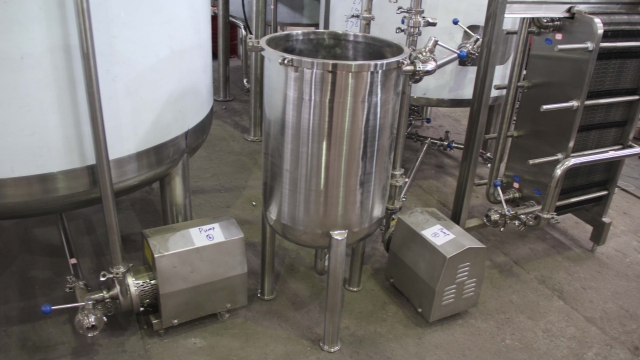Welcome to the world of brewing excellence! In the realm of craft beer, brewery equipment plays a pivotal role in creating unforgettable brews that leave beer enthusiasts craving for more. But what exactly is brewery equipment, you may ask? Well, it encompasses a wide range of machinery and tools specifically designed to facilitate the brewing process, from mashing and fermenting to packaging and serving. In this comprehensive guide, we will unveil the secrets behind top-notch brewery equipment, offering you insights into its different components, functionalities, and how to select the best equipment for your brewing endeavors. So, grab a pint and let’s dive in!
1. Understanding Brewery Equipment
Brewery equipment plays a vital role in the process of creating exceptional beverages. From the initial stages of brewing to the final bottling and packaging, having top-notch equipment is essential for achieving excellent results. In this section, we will dive into the world of brewery equipment, exploring its various components and their crucial functions.
First and foremost, let’s clarify what constitutes brewery equipment. Broadly speaking, it encompasses all the machinery, vessels, and instruments involved in the brewing process. From milling the grains to fermenting the brew, every step requires specific equipment designed to carry out its unique tasks. Whether it’s large-scale commercial brewery equipment or smaller home brewing setups, the core elements remain relatively similar in function.

One key component of brewery equipment is the brewhouse. This is where the magic happens—where the transformation of grains, hops, and water into delicious beer begins. The brewhouse typically consists of several vessels, including the mash tun, the lauter tun, the brew kettle, and the whirlpool. Each vessel has its distinct purpose in extracting and processing the essential ingredients, setting the foundation for exceptional brews.
Another crucial element of brewery equipment is the fermentation system. After the brew has been processed in the brewhouse, it undergoes fermentation to develop its unique flavors and aromas. Fermentation tanks, often made of stainless steel, are utilized to provide an optimal environment for yeast to convert sugars into alcohol. Temperature control and monitoring systems are also integral parts of the fermentation process, ensuring consistency and quality in the final product.
Lastly, we have the packaging equipment, which includes various machines that facilitate the bottling, canning, or kegging of the finished beer. These machines automate the packaging process, ensuring efficiency and precision while maintaining the freshness and integrity of the brew. From filling and capping to labeling and sealing, every step is crucial in presenting a professionally packaged product to consumers.
Understanding the different components of brewery equipment is essential for aspiring brewers or enthusiasts looking to enhance their brewing experience. By acquiring a comprehensive knowledge of these elements, one can make informed decisions when selecting or upgrading their brewery setup. In the next section, we will delve deeper into each aspect of brewery equipment, providing a comprehensive guide for those eager to unlock the secrets of brewing excellence.
2. Essential Brewery Equipment
Brewery equipment forms the backbone of any successful brewing operation. From small-scale craft breweries to large-scale industrial productions, the right equipment is essential for the creation of top-notch brews. So, what exactly constitutes brewery equipment? Let’s dive into it!
Fermentation Vessels:
Fermentation vessels are key components of brewery equipment. These vessels provide the ideal environment for yeast to convert sugars into alcohol, thus crucially determining the flavor and quality of the final product. Available in various sizes and materials such as stainless steel or glass, fermentation vessels must be carefully chosen to meet the specific needs of the brewery.Brewing Kettles:
Brewing kettles are where the magic happens. These large vessels are used for mashing grains and boiling wort, the liquid extracted from the grain. Precise temperature control and efficient heating mechanisms are vital in brewing kettles to achieve optimal enzymatic activity and extract full flavors from the ingredients.Cooling Systems:
Once the wort is brewed, it needs to be rapidly cooled down to the desired fermentation temperature. Cooling systems, including plate heat exchangers or glycol chillers, help achieve this with efficiency and precision. Maintaining proper cooling conditions not only ensures the quality of the beer but also contributes to the overall production efficiency.
Investing in high-quality brewery equipment is paramount for breweries aiming to produce exceptional brews consistently. Understanding the significance of fermentation vessels, brewing kettles, and cooling systems is just the beginning of uncovering the secrets behind top-notch brewery equipment.
Stay tuned for the next section where we will explore additional essential components that complete the brewery equipment setup.
3. Choosing the Right Brewery Equipment
When it comes to selecting the right brewery equipment, there are several key factors to consider. First and foremost, you need to evaluate your specific brewing needs and production goals. Understanding the scale and volume of beer you plan to produce is crucial in determining the size and capacity of the equipment required.
Another important aspect to consider is the quality and durability of the brewery equipment. Investing in reliable and well-built machinery can greatly contribute to the overall success and efficiency of your brewing operations. It’s advisable to opt for reputable manufacturers known for their expertise and superior craftsmanship.
Microbrewery Equipment
Additionally, don’t overlook the importance of customization options. Your brewery equipment should be flexible enough to adapt to your unique brewing processes and recipe formulations. Look for equipment that offers modular components and adjustable features, allowing you to tailor the brewing process to your specific requirements.
In conclusion, choosing the right brewery equipment is a decision that should be carefully considered. By evaluating your brewing needs, prioritizing quality and durability, and seeking customizable options, you can ensure that your brewery is equipped with top-notch equipment to achieve brewing excellence.

